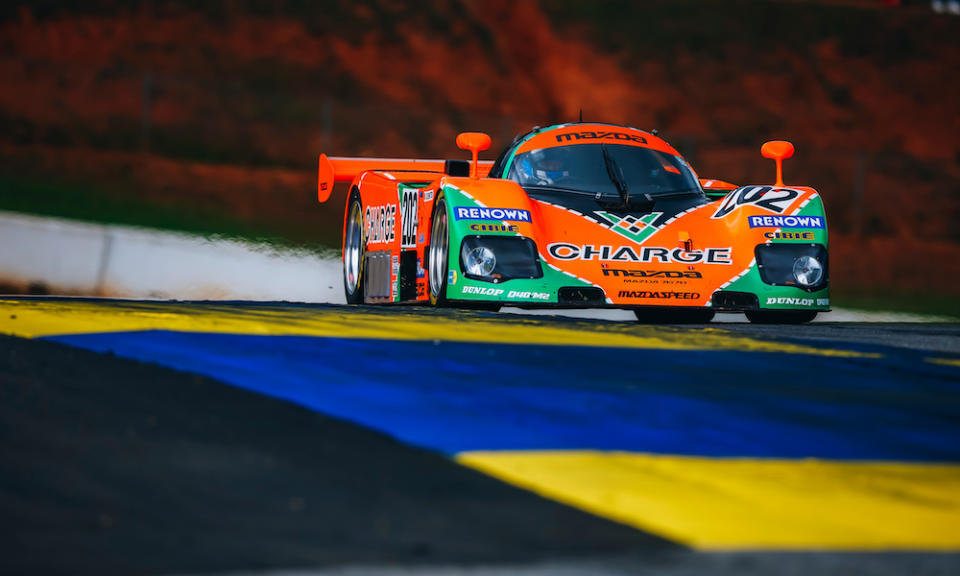Mazda Heritage Cars celebrate marque’s Le Mans Highlights

Mention “Mazda” and “24 Hours of Le Mans” and thoughts immediately go to 1991, when the Mazda 787B took the overall victory in auto racing’s premier international event. It was the first Japanese car to win the twice-around-the-clock enduro overall, and also the first and only overall victory at Le Mans for a rotary engine. The triumph marked the culmination of years of effort for the huge endurance classic as Mazda wrote its name on the global stage at the pinnacle of motorsport.
It also made history that was not to be repeated, as the following year, rotary engines were banned at Le Mans, effectively ending Mazda’s concentration on that premier event.
Weighing only 830kg, the Mazda 787B was powered by a four-rotor engine with a maximum output of 700PS, based on the production 13B engine. Volker Weidler (Germany), Johnny Herbert (UK) and Bertrand Gachot (France) were the winning drivers.
The stunning overall victory marked Mazda’s pinnacle of success in the French endurance gem, capping off the culmination of an effort that began in 1970 and included several class victories.
With Mazda enjoying success in American competition with the RX-7 in the Daytona 24 Hours and other events, the Japan-based Mazdaspeed explored opportunities at Le Mans. Mazdaspeed’s involvement at the 24 Hours first began in 1970, with a Chevron B16 prototype powered by a 10A Wankel-rotary engine. Four years later, a Sigma MC74 raced with a 12A rotary powerplant, but logged an insufficient number of laps to be classified at the finish.
After several IMSA-spec RX-7s fell short of a finish in the challenging French event, Mazda scored its first Le Mans finish in 1982 with a Mazdaspeed/Tom Walkinshaw Racing RX-7 powered by a 13B engine in the IMSA GTX category. Yojiro Terada, Takashi Yorino and Allan Moffat were co-drivers, placing sixth in IMSA GTX and 14th overall.
One year later, Mazda scored a 1-2 finish in Group C Junior with two 717Cs powered by 13B engines. The Japanese lineup of Terada, Yorino and Yoshimi Katayama placed 12th overall to win the new category, with future IMSA star James Weaver part of the second-place lineup.
Mazda moved up to Group C2 in 1984, winning the class with a Lola T616 running on BFGoodrich radial tires and powered by a twin-rotary 13B engine. Katayama joined John Morton and John O’Steen in placing 10th overall, while car owner Jim Busby placed 12th overall and third in class.
For 1986, Mazda moved up to IMSA GTP for Le Mans, running a Mazda 757 with a 13G triple-rotary engine. Both cars retired with driveline issues. Only one year later, the Mazda 757 triple-rotary won the GTP class, with Pierre Dieudonne and Irishmen David Kennedy and Mark Galvin placing seventh overall, the best finish to date for Mazdaspeed. The 757 repeated in GTP in 1988, with Terada, Dieudonne and Kennedy.
Next came the quad-rotary 767B, which continued Mazdaspeed’s GTP streak in 1989 with Kennedy, Dieudonne and Chris Hodgetts winning the class while the new car placed seventh, ninth and 12th overall. Terada, Yorino and Katayama made it four-in-a-row in 1990, taking 20th overall in a 767B in a race dominated by C1 machinery.
Mazdaspeed’s work paid off with the overall victory in 1991 with the Mazda 787B with an R26B four-rotor engine racing in the lead C2 category. The sister team car placed sixth with Kennedy, Stefan Johansson and Maurizio Sandro Sala, while a 787 was eighth with Terada, Yorino and Dieudonne.
That victory, and the ensuing rule change, marked the end of rotary-powered Prototypes at Le Mans. Mazda brought a pair of V-10-powered MX-R01s for 1992, with one of them finishing fourth. Terada joined up with Japanese Team Artnature to bring the IMSA GTO championship-winning Mazda RX-7 to Le Mans in 1994, joining Franco Freon and Pierre de Thoisy to place 15th overall and second in IMSA GTS.
The Mazda Heritage Collection includes three of the cars that brought Mazda glory at Le Mans.
Chassis 787-002 is the team car to the historic 1991 Le Mans overall winner. This chassis debuted at Le Mans in 1990, failing to finish. The following year, it placed eighth overall and second in class with Yorino, Terada and Dieudonne. The chassis debuted at Le Mans in 1990, failing to finish with Bertrand Gachot, Johnny Herbert and Volker Weidler.
Chassis 767B-002 is the team car to the 1989 Le Mans GTP class winner. It captured the GTP pole, took second in GTP and finished ninth overall with Elliott Forbes-Robinson, Yorino and Herve Regout. The chassis also won the GTP class at Suzuka.
Chassis RX-7-001 won the IMSA GTO championship for Pete Halmser, winning at Palm Beach, Miami and Mosport. This chassis also ran at Le Mans in 1994, second in IMSA GTS with Mazda legend Terada, Freon and de Thoisy for Japanese Team Artnature.
The next time race fans will be able to see these legendary cars in person is at the Rolex Monterey Motorsports Reunion at WeatherTech Raceway Laguna Seca, August 14 – 17.

 Yahoo Autos
Yahoo Autos 